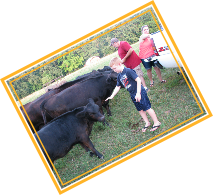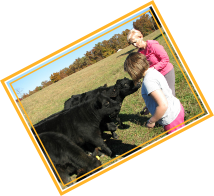
Holtz Country Ranch
1015 Lowery Road
Gilbertsville, KY 42044
(270) 205-0154
Psalm 50: 10 “For every beast of the field is mine, and the cattle upon a thousand hills.”


Amercian Aberdeen Angus
The Angus breed has its origins in eastern Scotland, in the counties of Aberdeen and Angus, where it was developed from the native black hornless cattle. Australian Lowline Cattle were developed from the Angus herd which was established at the Trangie Research Centre, in New South Wales, Australiain, in 1929 to provide quality breeding stock for the NSW cattle industry. Animal Scientists began with a herd of registered Champion Angus cattle that were carefully selected for high quality and small size. The end result was a breed of small, black, polled cattle with pure Angus genetics.
T he emphasis at Trangie switched to research, and in 1963 the Australian Meat Research Committee asked the Trangie Research Centre to conduct a project aimed at establishing the role of performance recording in the breeding program of a herd. The project continued until 1970, pioneering performance testing in Australia, and demonstrating successfully the usefulness of measuring performance in a stud herd.
he emphasis at Trangie switched to research, and in 1963 the Australian Meat Research Committee asked the Trangie Research Centre to conduct a project aimed at establishing the role of performance recording in the breeding program of a herd. The project continued until 1970, pioneering performance testing in Australia, and demonstrating successfully the usefulness of measuring performance in a stud herd.
The trials which produced the Lowline breed began in 1974, with funding from the Meat Research Corporation, to evaluate selection for growth rate on herd profitability. After 15 years of selective breeding, the Low Line herd had stabilized at about 30 percent smaller than the High Line cattle. The bulls were maturing at about 43 inches, and the cows at about 39 inches or less, against 59 inches for standard Angus bulls, and close to the same height for standard Angus cows. The Lowline Angus are docile, and well conformed. They offer small holders and those farmers with limited acreage available from their other activities the option of keeping docile cattle of high quality.
Lowlines answer the challenges of both the large scale rancher and the small acreage farmers. For the large scale ranch operation, Lowlines lower labor and veterinary costs and provide many economic advantages. Commercial heifers bred to fullblood Lowline bulls calve easily and breed back quickly, reducing the calving interval. Half-blood Lowline cows maintain themselves on about half the feed that is required by a full size crossbred cow and wean more pounds of calf per acre. Lowlines are also a perfect choice for small acreage farmers. Their small size makes them easy to handle and minimizes equipment requirements. Their feed efficiency improves the carrying capacity of a farm. They produce exceptional quality beef. They are ideal show animals for 4-H and other youth projects bringing in the next generation of cattle people. They may also offer the tax advantages of an agriculturally based property and business.
The Trangie researchers headed by Peter Parnell had not set out to create a new breed. Their aim was a controlled experiment in meat production. But they were good cattlemen , and their selection process produced a Low Line herd with the excellent conformation of their other stock. In 2017, there was a name change to American Aberdeen Angus.


